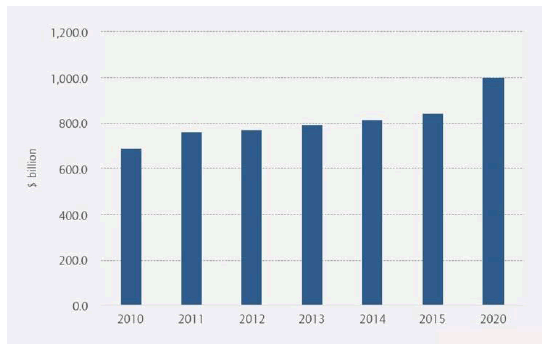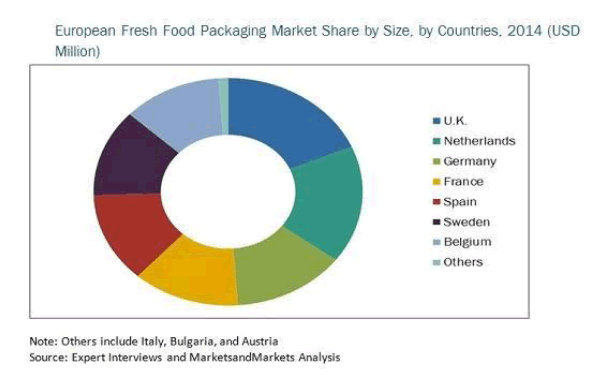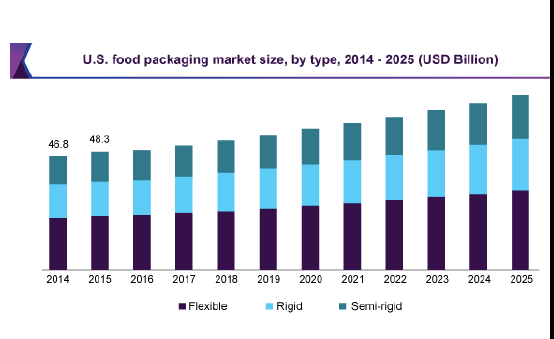ISSN : ISSN: 2576-1412
Journal of Applied Microbiology and Biochemistry
Food Packaging 2020 scheduled on August 31-Sep 01, 2020 at London, UK
BioComposites Centre - Bangor University, UK, E-mail: r.m.elias@bangor.ac.uk
Market Analysis
Food packaging is defined as an integrated food preparation system for transport, distribution, storage, retailing and, finally, the fulfillment of the consumer's wishes at a significant cost. Food packaging is a vital part of modern society; privately processed food could not be manufactured and sold safely and efficiently without packaging. The packaging is ubiquitous and important to today's society. This covers, improves and defends the products we buy, through production and producing, to handling and storage, to the final consumer. Without containers, product processing would be a noisy, wasteful and expensive task, and modem sales would be virtually impossible. The packaging industry accounts for about 2% of Gross National Product (GNP) in developed countries and about half of all packaging is used for food packaging. Today, a range of packaging materials and models are available to meet the requirements and demands of business and customers. Wrapping products can be categorized in several groups based on packaging materials such as metallic materials (tinplate, electrolytic chromium-coated steel, and aluminum), glass and paperboard Plastics, timber and other materials. (ceramics, organic fabrics, etc.)
Importance & Scope:
The packaging segment for food and beverage represents the largest share of the packaging sector and also comprises more than one-third of the overall packaging business. From an international perspective, the food packaging industry is at an exciting point where In the developed world, the industry has reached its peak, while the developing world is rising to transition to the latest technologies and supply chain management. Good food packaging defends from physical, chemical or biological harm and can also increase the consumer shelf life while drawing more consumers. The demand for food packaging is expected to grow differently in the coming year’s production facilities are being set up to meet the latest development and market trends. The planet is also witnessing drastic changes in behavior and food habits that are associated with the region's increasing population and economic development. The global food packaging industry is responsible for all of these factors. In comparison, people prefer processed food as a result of changing population dynamics from rural to urban areas. In 2012, the global market for food and beverage packaging materials amounted to $21.7 billion and $23 billion in 2013. It is estimated that this market will hit $31.3 billion by 2018,
rising from 2013 to 2018 at an annual compound growth rate (CAGR) of five years.
Market Research on Food Packaging On a global basis If there is an industry sector that is equally, if not more dynamic than the food sector, it is none other than the food packaging industry. Packing materials are generally used to contain the product, increase its shelf life, preserve product quality, and for hassle-free transportation and distribution. Packing material should extensively inhibit food spoilage. The packaging is also an effective tool for brand awareness and has a positive impact on market growth.
According to Statistics, the Global Food Packaging Market is valued at $63.32 billion in 2016 and is expected to reach $103.51 billion by 2023 growing at a CAGR of 7.33% from 2016 to 2023. The global market for appliances used in food and beverages packaging was $21.7 billion in 2012 and $23 billion in 2013. This market is expected to reach $31.3 billion by 2018, rising at a five-year compound annual growth rate (CAGR) of 6.3% from 2013 to 2018. The food packaging market is estimated to reach a value of $305,955.1 million and for beverage packaging is projected to reach $131.1 billion by 2019 at a CAGR of 4.4%.

North America
The North America Food Packaging Market was worth USD 43.38 billion in 2016 and estimated to be growing at a CAGR of 4.00%, to reach USD 63.51 billion by 2021. The gaining reputation of this market can be indorsed to increased demand for processed and packaged food and visual appeal of packaged food and convenience for use. The North America Food Packaging is broadly characterized into Material, Type and Application. Based on material packaging is classified as Paper and Board, Rigid Plastic, Metal, Glass, Flexible Plastic. Based on type packaging is classified as – Rigid, Semi-rigid and Flexible. Based on application packaging is classified as – Bakery, Confectionary, Convenience Foods, Dairy Products, Fruits and Vegetables, Sauces, dressing and condiments.
Europe
Between 2010 and 15 packaged food and drink consumption in Europe is projected to grow by 2% per annum, to exceed an annual volume of 864 billion packaging units by 2015, 80 billion more than in 2010. The packaged food and drink consumption in Europe is projected to grow by 3% per annum to 953 billion packages by 2020.The European fresh food packaging market is buyer-oriented. The food packaging market is directed by the increasing use of eco-friendly packaging technologies, which are inexpensive and manufactured from recycled material. To achieve sustainability, these eco-friendly technologies have played a vital role. The European fresh food packaging market is projected to reach USD 10,578.6 Million by 2020, with a CAGR of 2.13% from 2015 to 2020.

Asia Pacific
Food and beverage packaging market is by far the largest market of the packaging industry, accounting covering the one-third portion of global packaging market. From a global perspective, the food packaging market is at a very interesting situation, where the market has almost reached a peak point in terms of technology. The Asia-Pacific flexible food and beverages packaging market is expected to grow from US $26.51 billion in 2016 to US $47.32 billion by the end of 2021 at a CAGR of 10.14%. China is set to have the highest market share, followed by Japan and South Korea. This growth is attributed to the steady economic growth of the region. The GDP growth for 2016 - 2017 is forecasted to be more than 5% which is helped by growth in economies, robust credit growth, and good labour markets.
USA
The U.S. food industry is forecast to grow at a steady rate of 2.9% CAGR through 2022, according to the recently released 2016 Food Packaging Trends and Advances report from PMMI, The Association for Packaging and Processing Technologies. According to the report, the U.S. food industry stream the global market and, although North America is the largest global market across all food segments, the overall growth of the food industry, which includes food packaging, is being driven by emerging markets like Argentina, Brazil, China and India.

Target Audience:
• Food chemistry
• Food process engineers
• Food Technologist
• Food safety and standards
• Food quality managements
• Supply chain management of Food
• Food nanotechnology
• Food package testing
• Food laws and policies
• Food sensing technology
• Food Robotics science
• Biotechnologist
• Microbiologists
• Food Technicians
• Academicians
• Professors (Food Science)
• Researchers (Doctorates)
• Students (Post graduates)
• Food & Beverages Industries
• Private sectors
Individuals involved in Food Microbiology, Biotechnology, Nanotechnology and Food related matters.
Related Companies/Industries:
Major players in the food industry include
• Apetito
• Associated British Foods
• Cargill
• Coca-Cola
• General Mills
• GlaxoSmithKline
• Kellogg's
• Mars
• McCain Foods
• Mondelez
• Nestlé
• Pepsi
• Premier Foods
• Tate & Lyle
• Unilever
• United Biscuits
• Weetabix Limited
• Wm. Wrigley Jr. Company
Related Associations and Societies:
• Brewing, Food and Beverage Industry Suppliers' Association
• British Soft Drinks Association
• Chilled Food Association
• European Food Safety Authority
• Food Standards Agency
• The Food Commission
• FoodDrinkEurope - food industry confederation
• European Federation for the Science and Technology of Lipids
• Institute of Food Technologists
• Institute of Food Science & Technology
• EFFoST (European Federation of Food Science and Technology)
• IUFoST (International Union of Food Science and Technology)
• European Cocoa Association
• BEAUC (the European Consumer Organisation)
• EFFCA (European Food and Feed Cultures Associations)
• EFFAT (European Federation of Food, Agriculture and Tourism Trade Unions)
• AIM - European Brands Association
• Profel, The European Association Of Fruit And Vegetable Processors
• FEDIAF - European Pet Food Industry Federatio
• Europabio, The European Associa
Open Access Journals
- Aquaculture & Veterinary Science
- Chemistry & Chemical Sciences
- Clinical Sciences
- Engineering
- General Science
- Genetics & Molecular Biology
- Health Care & Nursing
- Immunology & Microbiology
- Materials Science
- Mathematics & Physics
- Medical Sciences
- Neurology & Psychiatry
- Oncology & Cancer Science
- Pharmaceutical Sciences
